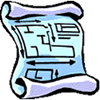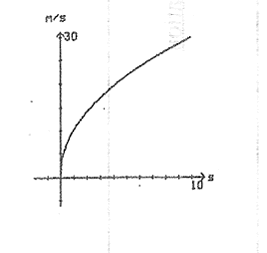

Chapter
6 Review
More Questions
1. Use the table below to find the average acceleration of the car from time t=20 to t=22. Answer: 6.0 m/s2
time (s) |
car's velocity (m/s) |
20 |
6 |
21 |
12 |
22 |
18 |
23 |
24 |
24 |
30 |
2. Use the velocity-time graph below to
(a) estimate the average acceleration between time t=4 and t=9. Answer:
1.8 m/s2
(b) estimate the instant acceleration at time t=3.Answer:
2.7m/s2

3. A plane with a velocity of 94 m/s is accelerated uniformly at a rate of 4.0 m/s2 for 3.4s. What is the plane's final velocity? Answer: 110m/s
4. A car traveling at a speed of 25 m/s brakes at a uniform -4.0 m/s2 for 6.0s. How far does the car travel during that time? Answer: 78 m
5. An airplane with a velocity of 32 m/s needs to reach a velocity of 78 m/s for takeoff. If there is only 0.60 km of unway left, what must the constant acceleration be? Answer: 4.2 m/s2
6. A feather is falling at a constant velocity of 4.0 m/s. As the feather
passes a ledge that is 78.4 hight a rock is dropped from the ledge.
a) How far below the ledge will the feather be when the rock reaches the
ground? Answer:
16 m
b) How high is the cliff? Answer:
39 m/s
7. A bullet is fired straight up with an initial velocity of 109 m/s.
It passes the top of a cliff with a velocity of 55.1 m/s.
a) When the bullet passes the top of the cliff, how long has it been since
it was firts? Answer:
5.50 m
b) How high is the cliff? Answer:
451 m
8. After making a delivery, a truck driver must maneuver the vehicle
backwards down a narrow ramp. The speed of the truck increases with distance
down the ramp. Describe the truck's acceleration.
Answer: Because the truck's velocity is backward,
or negative, the acceleration is also negative even though the truck's
speed is increasing.
9. How can you find the instantaneous acceleration of an object whose
curve on the velocity-time graph is a straight line?
Answer: The instantaneous acceleration is the slope of the curve on such
a graph
10. Suppose an object starts at rest. Explain how the displacement of
the object, which has a constant acceleration, can be determined from
a velocity-time graph.
Answer: The displacement is the area under the curve on such a graph.
The curve in this case is a straight line. The triangular area under the
curve equals the displacement of the object.
11. Describe the curve on a position-time graph of an object with a constant
velocity. How does the curve differ for an object with a constant velocity.
How does the curve differ for an object that is accelerating constantly?
Answer: For an object with a constant velocity, the curve is a straight
line. For an accelerating object, the curve is half of a parabola.
12. Derive an equation for determining displacement when velocity and
acceleration are known.
Answer: By using d=1/2(vf +vi) and (vf-vi)/a=t and
substituting the second equation into the first, displacement can be calculated
using the equation: d= (v2f - v2i)/2a.
13. How is the acceleration of an object in free fall related to acceleration
due to gravity?
Answer: For an object in freefall, a=g.
14. In your own words, state the first and last steps that are critical
to solving any physics problem.
Answer: The problem must first be carefully read
and analyzed. Making a sketch could be helpful. Once the problem is solved
systematically, the answer should be evaluated to determine whether or
not the numerical value is reasonable.